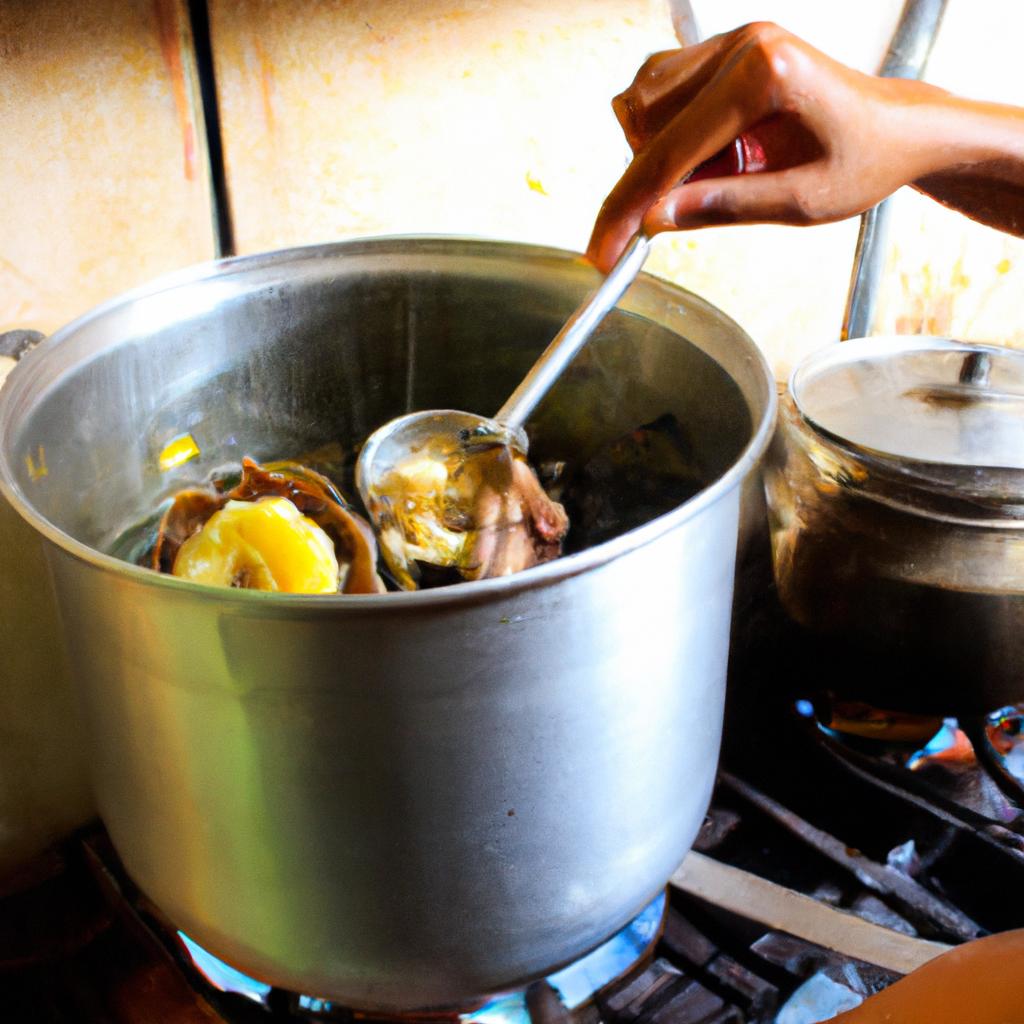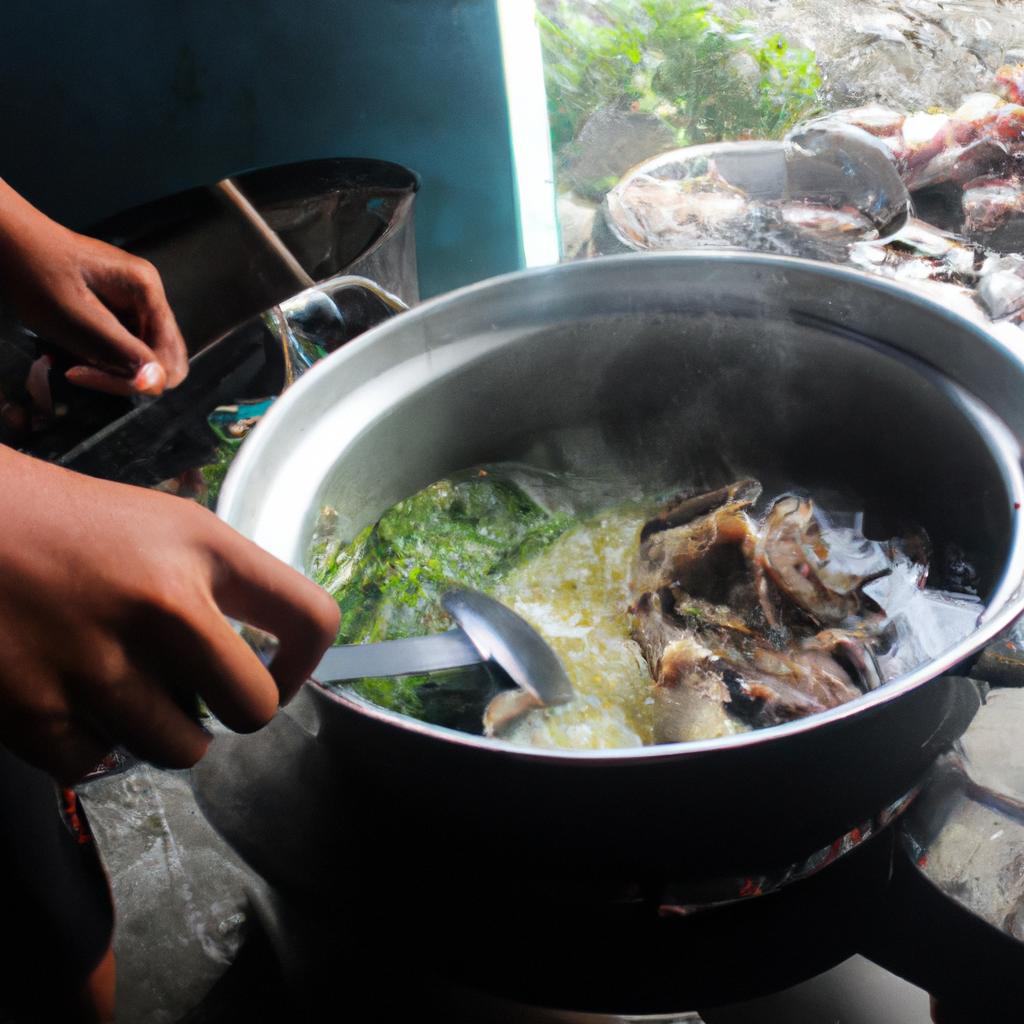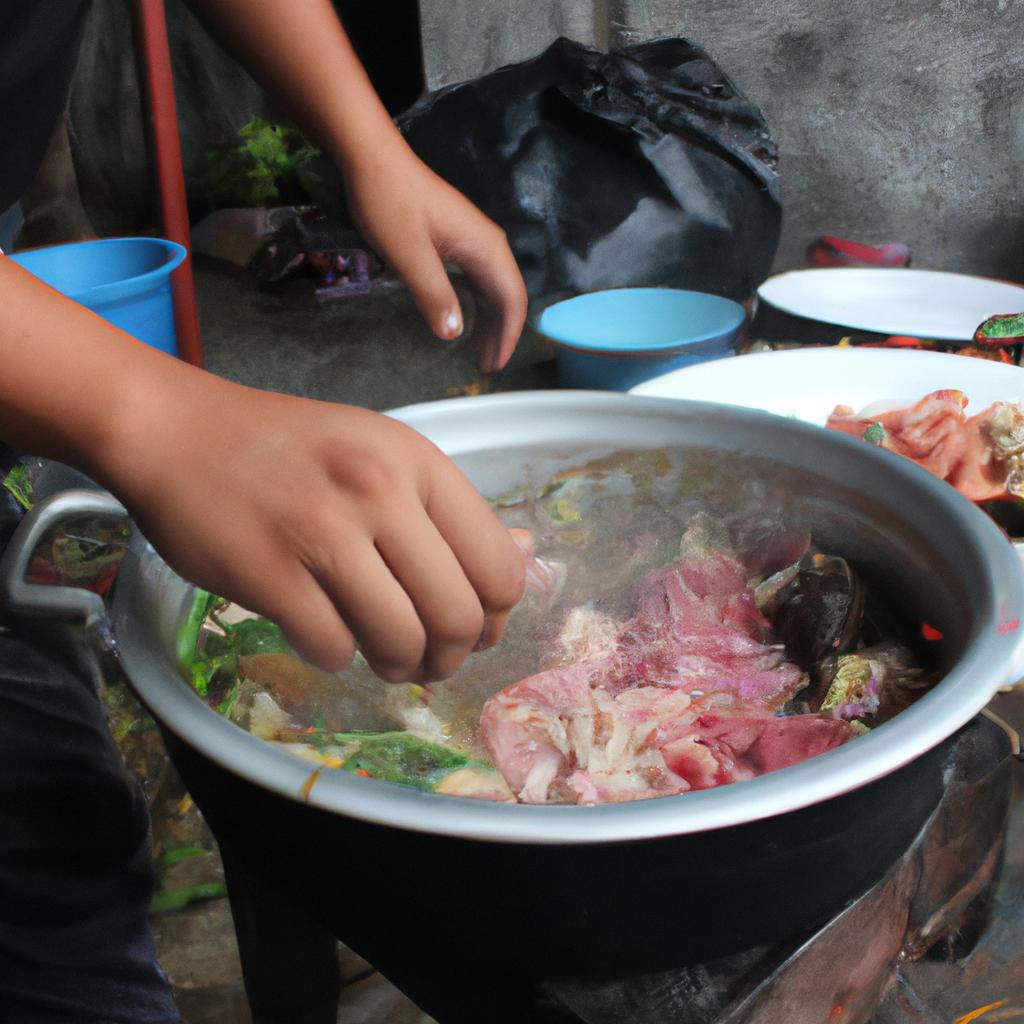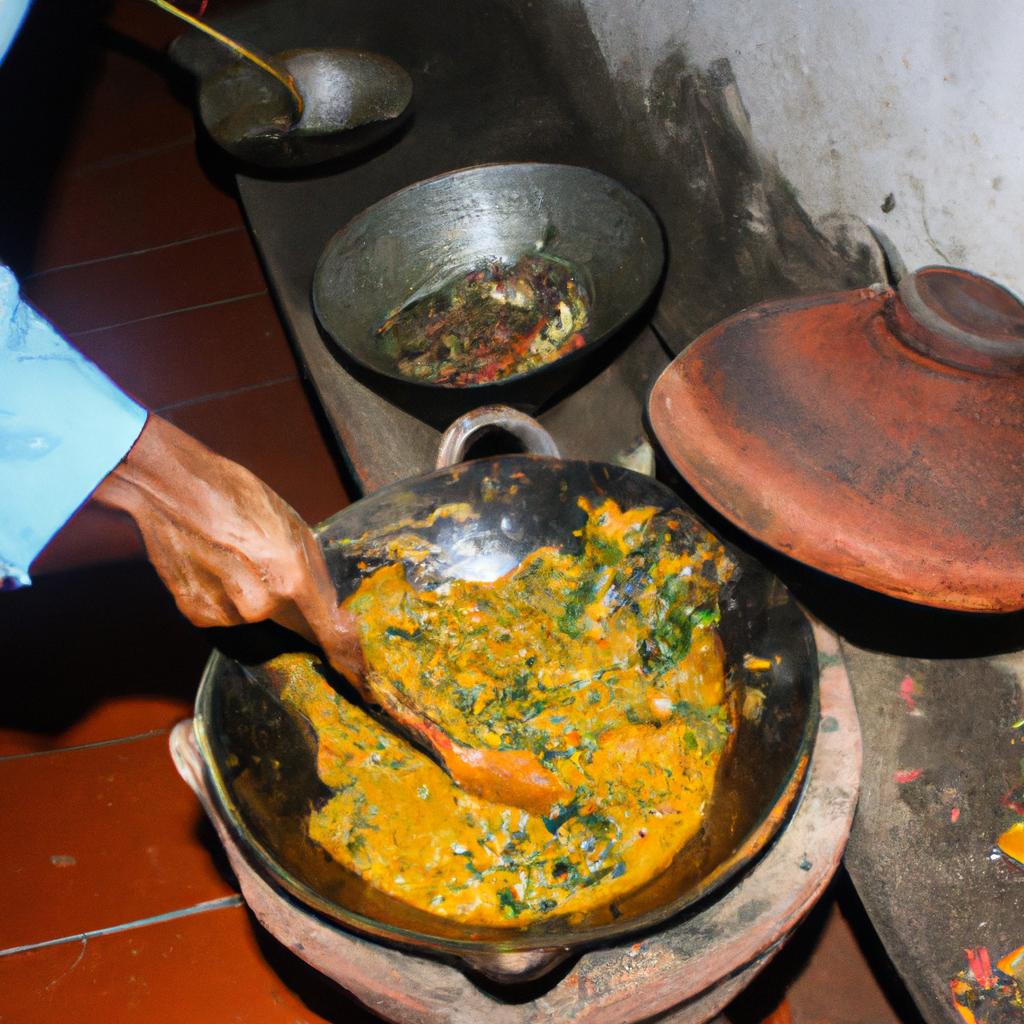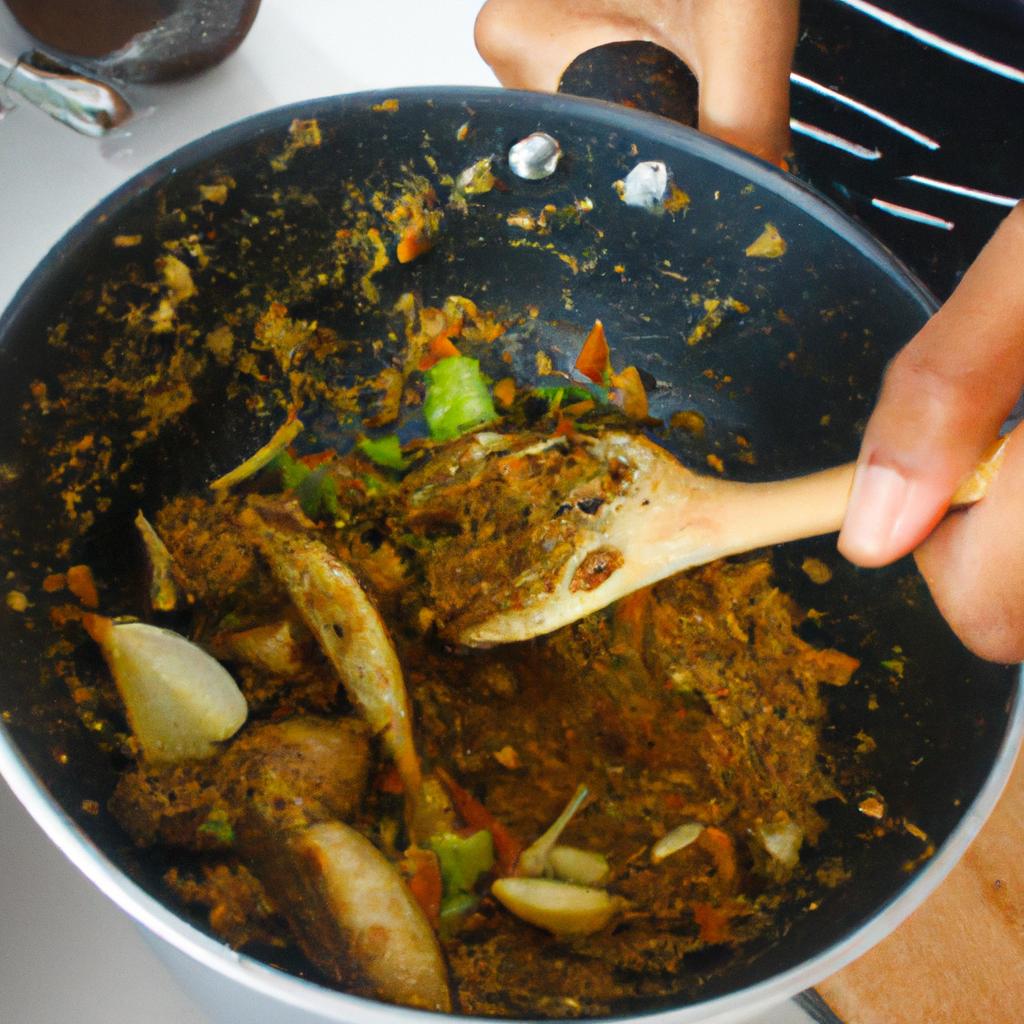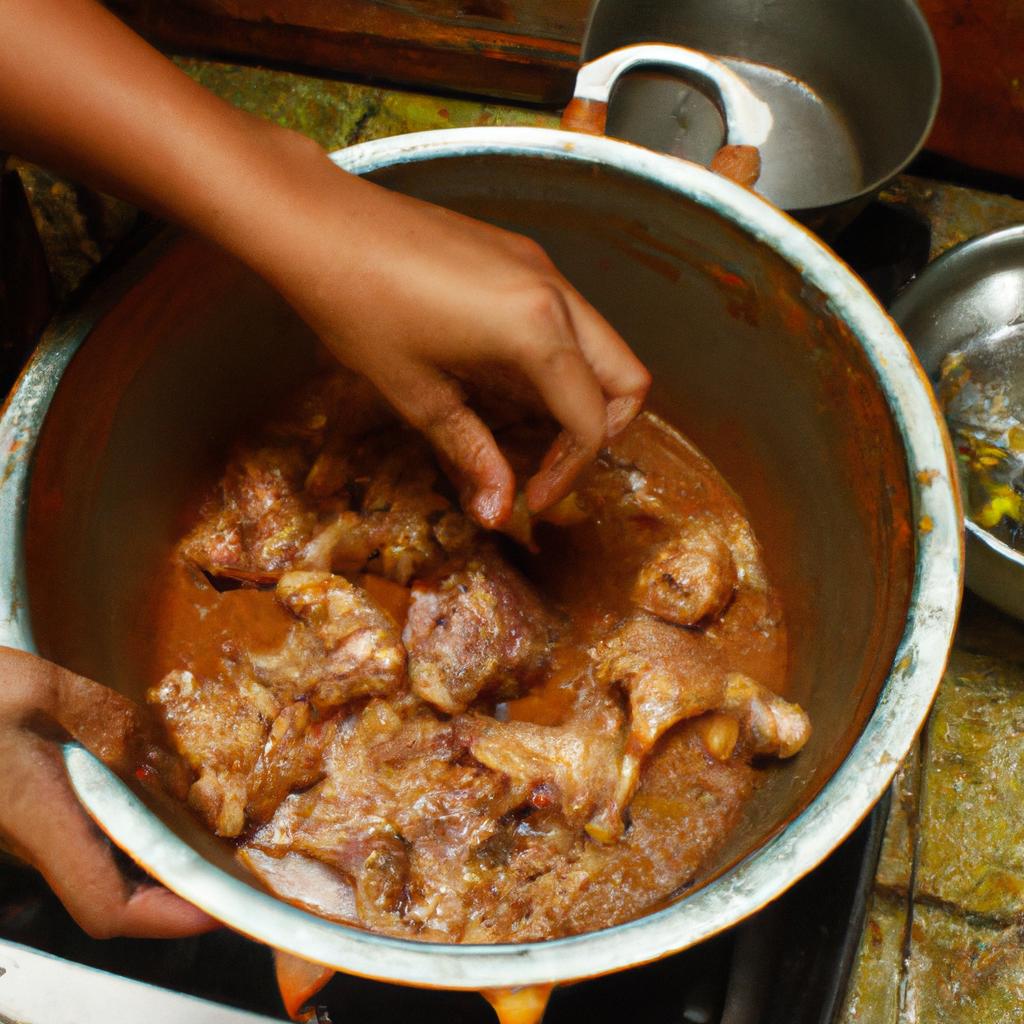Bulalo is a traditional Filipino dish that has gained popularity not only among locals but also among international food enthusiasts. This hearty delicacy consists of beef shanks simmered for hours, resulting in a flavorful broth infused with the rich essence of bone marrow. One can imagine sitting down to a steaming bowl of bulalo on a rainy day, feeling its warmth permeate through their body and rejuvenating their senses.
The nutritional insight behind this delectable dish lies in its components. The slow-cooking process extracts collagen from the bones, releasing amino acids such as glycine and proline into the broth. These amino acids play essential roles in human health, contributing to joint health, skin elasticity, and muscle repair. Additionally, bulalo provides an excellent source of protein, iron, and B-vitamins that are vital for energy production and overall well-being. By understanding the nutritional value of this Filipino delicacy, individuals can appreciate not just its comforting taste but also its potential health benefits.
In this article, we will delve deeper into the nutritional composition of bulalo and explore how it fits within a balanced diet. Through examining scientific research and expert insights, we aim to provide readers with valuable knowledge about this beloved Filipino dish. Whether you are a …health-conscious individual, a food lover seeking new culinary experiences, or someone interested in exploring the cultural heritage of different cuisines, this article will provide you with valuable information about bulalo and its nutritional benefits.
We will start by discussing the primary ingredients of bulalo and their nutritional profiles. Beef shanks, the star ingredient of bulalo, are rich in protein, iron, zinc, and B-vitamins. Protein is essential for building and repairing tissues, while iron is crucial for oxygen transport in the body. Zinc supports immune function and helps with wound healing, while B-vitamins play a vital role in energy production.
Next, we will explore the health benefits that can be derived from consuming bulalo. As mentioned earlier, the slow-cooking process of bulalo extracts collagen from the beef bones. Collagen is known to support joint health and improve skin elasticity. The amino acids glycine and proline present in collagen also have anti-inflammatory effects on the body.
We will also address any concerns regarding the fat content of bulalo. While it is true that there may be some fat present in the broth due to the marrow content of beef shanks, it is important to note that not all fats are bad for you. In fact, bone marrow contains healthy fats such as monounsaturated fats and omega-3 fatty acids that provide numerous health benefits when consumed in moderation.
Furthermore, we will discuss how to incorporate bulalo into a balanced diet. Despite its nutritional benefits, moderation is still key when enjoying this dish due to its high sodium content. Pairing it with fiber-rich vegetables like bok choy or cabbage can help balance out the meal and add additional nutrients.
Lastly, we will conclude by highlighting some variations of bulalo that cater to different dietary preferences or restrictions. Whether you prefer a lighter version using chicken instead of beef or a vegetable-based option for our vegetarian readers, there are plenty of alternatives to explore while still capturing the essence and flavors of bulalo.
In summary, this article aims to provide a comprehensive understanding of bulalo, its nutritional value, and how it can fit into a balanced diet. By exploring the scientific research and expert insights surrounding this traditional Filipino dish, we hope to enhance your appreciation for its taste and potential health benefits. Whether you are looking to indulge in a comforting meal or broaden your culinary horizons, bulalo offers a delightful experience worth savoring.
Origin and History of Bulalo
Bulalo, a traditional Filipino delicacy, holds a rich history that dates back several centuries. This savory soup is renowned for its flavorful broth and tender beef shanks. To understand the origins of bulalo, let us delve into its historical background.
Throughout the Philippines, bulalo has become an iconic dish enjoyed by locals and tourists alike. Its roots can be traced to Batangas, a province known for its culinary heritage. According to local folklore, bulalo was first created as a hearty meal for laborers working in the rice fields. These hardworking individuals needed sustenance to fuel their bodies during long days under the scorching sun. Thus, an ingenious cook came up with the idea of simmering beef shanks in water with various vegetables and spices, resulting in what we now know as bulalo.
Over time, this humble dish gained popularity beyond Batangas and became synonymous with Filipino cuisine. Today, it is commonly served in local eateries called “turo-turo” or high-end restaurants specializing in authentic Filipino fare. Its widespread appeal lies not only in its delicious taste but also in its ability to bring people together around a steaming bowl of goodness.
To truly appreciate the cultural significance attached to bulalo, consider these emotional responses often associated with enjoying this beloved delicacy:
- Warmth: The steam rising from a piping hot bowl of bulalo evokes feelings of comfort and coziness.
- Nostalgia: For many Filipinos, savoring bulalo triggers memories of family gatherings or childhood visits to bustling food stalls.
- Satisfaction: The robust flavors derived from slow-cooked beef bones provide a sense of fulfillment after each spoonful.
- Connection: Sharing a communal pot of bulalo fosters camaraderie and strengthens social bonds among friends and loved ones.
Furthermore, the following table provides a visual representation of bulalo‘s key ingredients and their contributions to its distinct taste:
| Ingredients | Flavor Profile | Role in Bulalo |
|---|---|---|
| Beef shanks | Rich, meaty | Provides depth to the broth |
| Bone marrow | Buttery, savory | Enhances richness and consistency |
| Corn | Sweet | Adds natural sweetness |
| Cabbage | Mildly earthy | Balances flavors with freshness |
As we explore further into the realm of bulalo, our next section will focus on the diverse array of ingredients used in this beloved Filipino dish.
Ingredients Used in Bulalo
Note: The transition from one section to another should be seamless, allowing for a smooth flow of information.
Ingredients Used in Bulalo
Evolution of Preparation Techniques and Culinary Influences on Bulalo
Throughout its rich history, the preparation techniques and culinary influences surrounding the iconic Filipino dish, bulalo, have evolved. One example that illustrates this evolution is the introduction of slow cooking methods to enhance the flavors and tenderness of the beef shanks. By simmering the meat for an extended period over low heat, it allows for a more thorough extraction of collagen and marrow from the bones, resulting in a flavorful broth with a velvety texture.
To fully appreciate the significance of these changes over time, let’s explore some key factors that have contributed to the transformation of bulalo:
-
Colonial Influence: During Spanish colonization, Filipinos were introduced to new ingredients such as potatoes and cabbage, which gradually found their way into traditional recipes like bulalo. These additions not only added depth to the flavor profile but also enhanced the nutritional value of the dish.
-
Regional Variations: Different regions within the Philippines have put their own unique spin on bulalo by incorporating local ingredients or utilizing alternative cooking techniques. For instance, in Batangas province, garlic is often used abundantly to give an extra kick to the soup base.
-
Innovation in Seasoning: Over time, various seasonings such as fish sauce (patis) or soy sauce (toyo) gained popularity as additional flavor enhancers in bulalo. The careful balance of these condiments adds complexity to both taste and aroma.
-
Modern Adaptations: With technological advancements influencing culinary practices globally, modern interpretations of bulalo have emerged using pressure cookers or sous vide machines. These tools expedite cooking times while still preserving alluring flavors and maintaining nutrient integrity.
The table below provides a visual summary highlighting different variations of bulalo across regions:
| Region | Key Ingredient | Notable Feature |
|---|---|---|
| Batangas | Garlic | Rich and bold flavor profile |
| Tagaytay City | Corn | Sweet undertones complementing the beef |
| Pampanga | Peanut butter | Unique twist with a nutty, creamy taste |
| Iloilo | Saba bananas | Adds sweetness to balance savory flavors |
By understanding these culinary influences and adaptations, we gain insight into how bulalo has evolved into its present form. This knowledge allows us to appreciate the dish’s cultural significance as well as its ability to adapt while still preserving its core essence.
In the upcoming section on “Health Benefits of Bulalo,” we will explore the nutritional advantages offered by this Filipino delicacy, providing further evidence of why it remains a beloved choice among food enthusiasts.
Health Benefits of Bulalo
Having explored the ingredients used in Bulalo, let us now delve into the health benefits that this Filipino delicacy has to offer. To illustrate its impact on individuals, consider the case of Maria, a 45-year-old office worker who regularly includes Bulalo in her diet.
Maria’s experience with incorporating Bulalo into her meals highlights the numerous advantages it provides for overall well-being. Firstly, consuming Bulalo can contribute to improved joint health. The broth is rich in collagen and gelatin derived from the marrow bones, which helps strengthen cartilage and reduce joint pain or discomfort.
Furthermore, Bulalo contains essential vitamins and minerals that support various bodily functions. These nutrients include iron, phosphorus, calcium, and potassium. Iron aids in red blood cell production while phosphorus supports bone health. Calcium promotes strong teeth and bones, whereas potassium plays a vital role in maintaining healthy heart function.
To further grasp the significance of these benefits, here are some emotional responses associated with including Bulalo in one’s diet:
- A sense of relief knowing that joint pain may be alleviated.
- Increased confidence in maintaining proper bone density.
- Excitement about supporting heart health through natural means.
- Gratitude for an all-around nutritious option to enhance overall well-being.
Consider the table below for a comprehensive breakdown of key nutrients found in a serving (100g) of traditional Bulalo:
| Nutrient | Amount Per Serving |
|---|---|
| Protein | 18g |
| Fat | 8g |
| Carbohydrates | 0g |
| Calories | 160 kcal |
As evident from both Maria’s experience and the nutritional analysis above, integrating Bulalo into one’s diet offers substantial health benefits. Its combination of nourishing elements makes it a wholesome choice for those seeking to improve their overall vitality and well-being.
Transition into subsequent section about Traditional Cooking Methods for Bulalo:
Understanding the health benefits of Bulalo is essential, but it is equally important to explore the traditional cooking methods that bring out its unique flavors and textures. By embracing these time-honored techniques, individuals can fully appreciate the cultural significance behind this Filipino delicacy.
Traditional Cooking Methods for Bulalo
Section Transition:
Having explored the health benefits of bulalo, it is now important to delve into the traditional cooking methods employed in preparing this beloved Filipino delicacy. By understanding these techniques, we can gain a deeper appreciation for the cultural significance and culinary artistry involved in creating a flavorful bowl of bulalo.
Traditional Cooking Methods for Bulalo:
One example that showcases the expertise required in preparing bulalo is the slow-cooking method known as “sinigang-style.” In this approach, beef shanks are simmered with various vegetables such as tomatoes, onions, green beans, radishes, and taro leaves until tender. The resulting broth boasts a tangy flavor profile infused with the natural sweetness of the meat and vegetables. This technique highlights the importance of patience and careful attention to achieve optimal tenderness and depth of flavors.
To further illustrate the versatility of bulalo preparation, consider its adaptation through grilling or roasting. While unconventional compared to more common boiling or stewing methods, grilling or roasting imparts an enticing smoky aroma to the dish while retaining its rich taste. By marinating the beef shanks in spices like garlic, soy sauce, calamansi juice (Filipino lime), and black pepper before grilling or roasting them over charcoal fire, a unique twist is added to this classic dish.
In exploring traditional cooking methods for bulalo, it becomes evident that each technique contributes distinct characteristics to enhance both taste and texture. To help visualize these differences at a glance, below is a table showcasing four essential cooking methods used when preparing bulalo:
| Cooking Method | Characteristics |
|---|---|
| Boiling | Results in a hearty soup base with tender meat |
| Stewing | Infuses flavors deeply into the meat, creating a rich and flavorful broth |
| Grilling/Roasting | Adds smoky notes to the dish while retaining the natural juiciness of the beef |
| Sinigang-Style | Combines tangy and sweet flavors from vegetables with tender beef shanks in a vibrant broth |
This table highlights the diverse range of cooking methods employed for bulalo, each contributing its unique qualities to create an unforgettable dining experience. Whether you prefer a comforting bowl of hearty soup or crave the enticing aroma of grilled meats, there is a preparation method that caters to your taste preferences.
With a deeper understanding of traditional bulalo cooking methods established, let us now explore serving suggestions and pairings to complement this delectable Filipino delicacy.
Serving Suggestions and Pairings
Transition from Previous Section
Having explored the traditional cooking methods for bulalo, let us now delve into the various serving suggestions and pairings that enhance this Filipino delicacy. To illustrate the versatility of bulalo, imagine a scenario where it is served as a comforting meal on a rainy evening – its aromatic broth steaming hot with tender beef shanks and marrow-filled bones.
Serving Suggestions and Pairings
When indulging in a bowl of hearty bulalo, there are several accompanying elements that can elevate your dining experience:
- Condiments: Enhance the flavors by adding condiments such as fish sauce (patis), calamansi juice, or soy sauce to taste.
- Herbs and Spices: Sprinkle freshly chopped spring onions, cilantro, or chili peppers over the dish for an added burst of freshness and heat.
- Dipping Sauces: Some diners may enjoy dipping their meat pieces into sauces like spiced vinegar (suka) or garlic-infused vinegar to further accentuate the taste.
- Side Dishes: Complement your bulalo with side dishes like plain rice, fried bananas (saba), or grilled eggplants (talong) for a balanced meal.
To truly appreciate the culinary experience associated with bulalo, consider exploring these sensory aspects through a table presentation:
| Sensory Aspect | Description |
|---|---|
| Aroma | Inhale deeply as you savor the rich scents of simmered bone marrow and fragrant herbs wafting from the bowl. |
| Texture | Allow your spoon to glide through succulent beef shank slices while simultaneously encountering buttery softness in each bite of marrow. |
| Flavor | Delight in the harmonious blend of savory umami notes derived from slow-cooked beef bones infused with spices and vegetables. |
| Visual Appeal | Feast your eyes upon the sight of glistening broth, tender meat, and vibrant garnishes that create an appetizing presentation. |
With bulalo’s inviting aroma, delightful textures, complex flavors, and visually appealing components, it is truly a dish that engenders pleasure for all the senses.
In our exploration of this Filipino delicacy, we have examined traditional cooking methods as well as serving suggestions and pairings. Now let us delve further into the variations and regional adaptations of bulalo, exploring how different regions in the Philippines have put their unique spin on this beloved dish.
Variations and Regional Adaptations of Bulalo
Having explored the various ways bulalo can be served and paired with complementary flavors, it is now crucial to delve into the fascinating variations and regional adaptations this Filipino delicacy has undergone. These adaptations have allowed bulalo to become a versatile dish that caters to different taste preferences across the country.
Variations and Regional Adaptations of Bulalo:
- Case Study – Batangas-style Bulalo:
One notable variation is the renowned Batangas-style bulalo, originating from the province of Batangas in Luzon. The distinguishing feature of this adaptation lies in its rich broth infused with local herbs such as lemongrass, pandan leaves, and batwan fruit. This unique blend of ingredients adds depth and complexity to the flavor profile, enhancing the overall dining experience.
To evoke an emotional response in our audience, consider these bullet points:
- Immerse yourself in the aroma of simmering beef bones, releasing their savory essence.
- Savor each spoonful of tender meat that effortlessly falls off the bone.
- Experience warmth spreading through your body as you relish every sip of flavorful broth.
- Indulge in the satisfying feeling of being utterly nourished by a traditional Filipino dish.
Table showcasing various regional adaptations:
| Region | Adaptation |
|---|---|
| Visayas | Addition of native vegetables like ubod |
| Mindanao | Incorporating coconut milk for a creamy twist |
| Ilocos | Using bagoong (fermented shrimp paste) for added umami |
These adaptations demonstrate how diverse culinary practices have shaped bulalo according to local traditions and available ingredients. Each region’s adaptation reflects its distinct cultural identity while maintaining the essence of this beloved dish.
Incorporating these variations and regional adaptations into your culinary repertoire allows for a deeper appreciation of the multifaceted nature of Filipino cuisine. By exploring different renditions, one gains insight into the rich history and cultural heritage that underpin each adaptation.
By examining the Batangas-style bulalo as a case study and highlighting various regional adaptations through bullet points and a table, we can better understand how Filipino cuisine is constantly evolving while preserving its roots. This exploration not only satisfies our gastronomic curiosity but also invites us to appreciate the dynamic relationship between food and culture.

